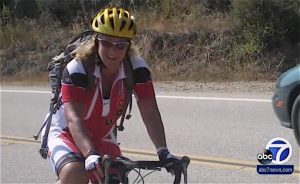 The Coflex Device Offers An Alternative To Spinal Fusion After Decompression, May Offer Best Treatment To Preserve Range Of Movement For The Right Patients, says Robert Rovner, MD.
The Coflex Device Offers An Alternative To Spinal Fusion After Decompression, May Offer Best Treatment To Preserve Range Of Movement For The Right Patients, says Robert Rovner, MD.
Danville, CA – Kim is a 50-something who loves to be active. She participates in marathon bike rides and loves to hike in the mountains.That was until the onset of intense low back pain threatened to keep Kim from her favorite activities.“Pain was radiating from my lower back and down my legs,“ she says. “Sitting down was the only way I could make the pain stop.”
Dr. Rovner’s patient Kim rides her bike again after treatment for spinal stenosis.
Spine surgeon Dr. Robert Rovner diagnosed Kim with lumbar spinal stenosis.
Lumbar spinal stenosis refers to a narrowing of the spinal canal in the lower back caused by bone and / or tissue growth in the openings in the spinal bones. This narrowing can compress and irritate the nerves that branch out from the spinal cord. Symptoms can include pain, numbness, or weakness. Vertebrae in Kim’s lower back had become unstable, putting painful pressure on surrounding nerves. Serious cases can require spinal fusion after a decompression procedure but Dr. Rovner recommended a less invasive procedure using “Coflex” a titanium clip-like device.
“Lower back and leg pain caused by lumbar spinal stenosis may now be treated in many cases without resorting to spinal fusion,” says Dr. Rovner, of Disc & Spine in Danville, CA. “This less invasive procedure preserves range of motion and allows for a more rapid recovery.”
Dr. Rovner says that spinal stenosis is usually treated with a procedure called a “laminectomy” to decompress the nerves, combined with fusion to stabilize the spine. With the Coflex procedure, the clip is placed between two vertebrae immediately after a laminectomy is completed. The spring-like device allows the back to flex while providing support.
“A recently published five-year randomized prospective outcome study of laminectomy and Coflex patients shows outcomes equal to or better than patients who were treated with a combination of laminectomy and fusion. Additionally, there were fewer revision surgeries necessary in the Coflex group during the five years of the study.” (International Journal of Spine Surgery, Michael Musacchio, MD – source: http://ijssurgery.com/10.14444/3006)
“Before Coflex became available I was not used to seeing such rapid recovery and return to function with patients in whom I’ve done either a simple laminectomy alone or laminectomy combined with fusion,” says Dr. Rovner.
Dr. Rovner says that patients with more advanced stenosis may not be candidates for the Coflex implant and may require more extensive surgery or spinal fusion. “It’s important to consult with a board certified spine surgeon who offers several alternatives for treatment depending on each patient’s condition,” he says.
For more information or to book an appointment call Disc & Spine at 925-275-0700. discandspine.com


 Robert Rover, MD a San Francisco Bay Area spine surgeon is performing a surgical technique to bring better outcomes in scoliosis surgery, as reported by Becker’s Spine Review.
Robert Rover, MD a San Francisco Bay Area spine surgeon is performing a surgical technique to bring better outcomes in scoliosis surgery, as reported by Becker’s Spine Review.